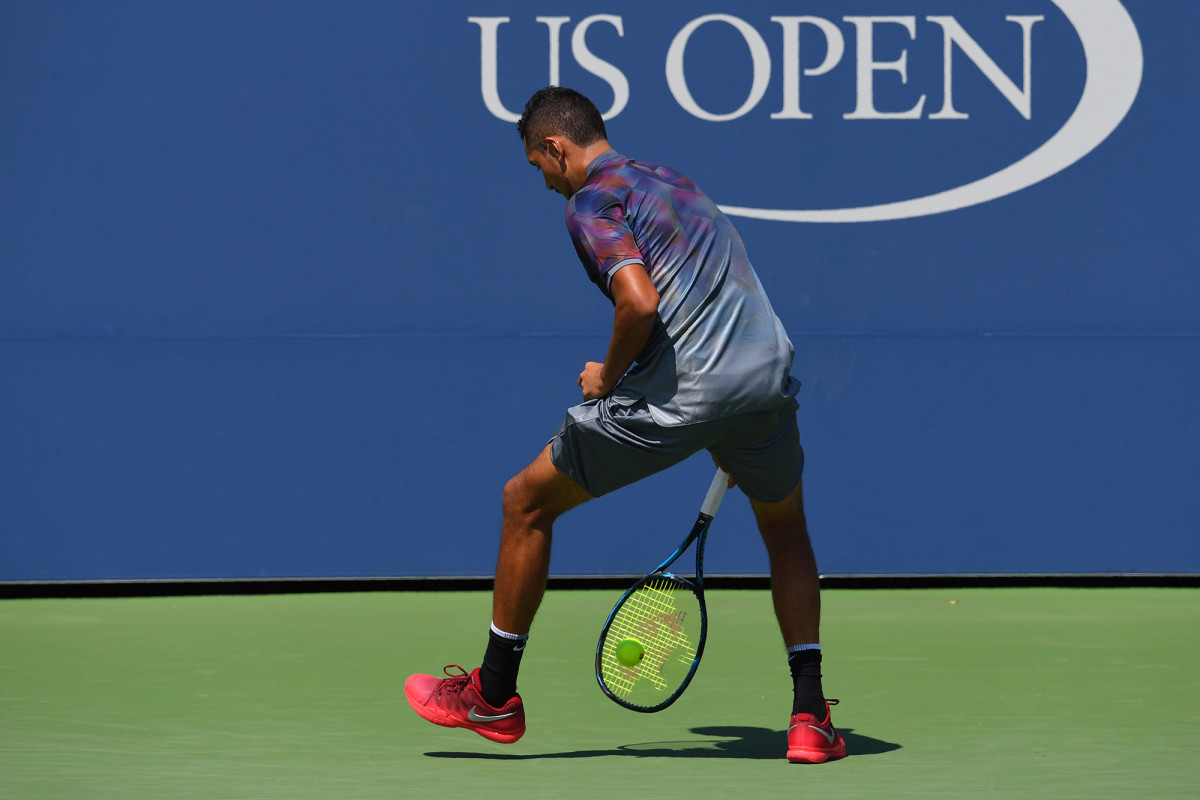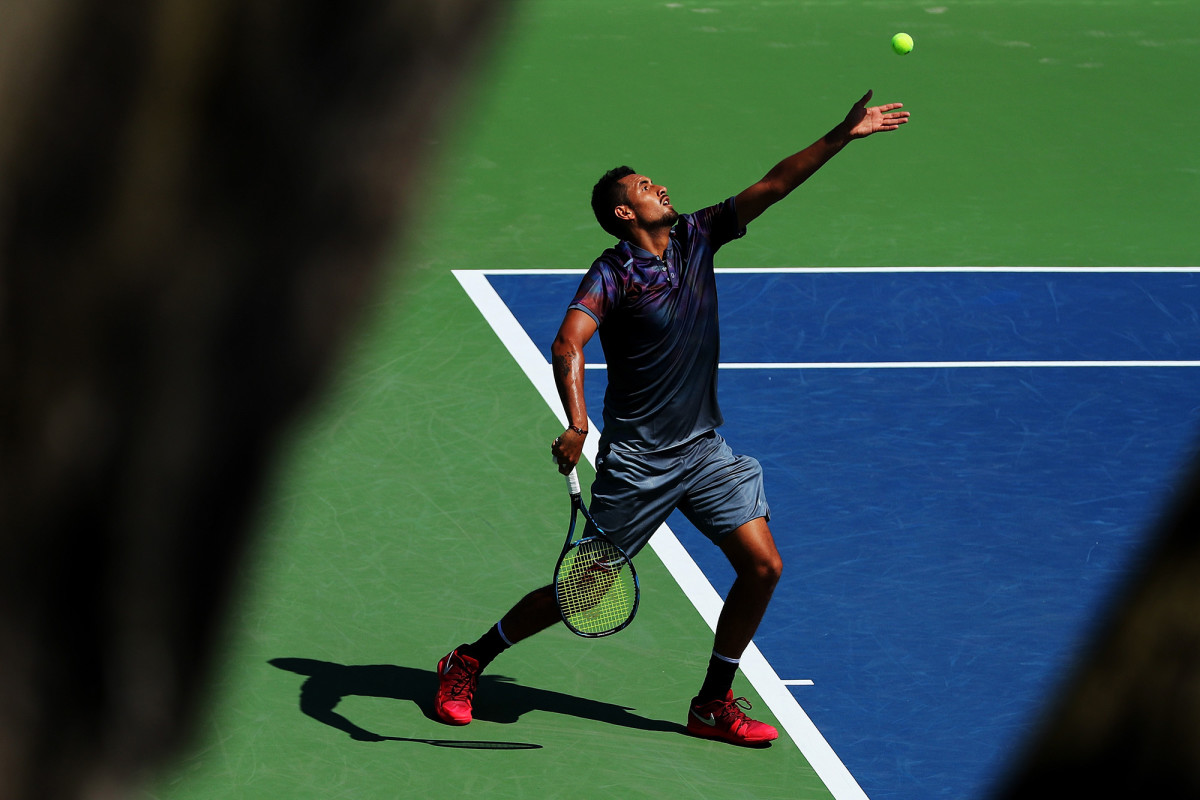Nick Kyrgios Makes Tennis More Interesting, and That's What Matters

Nick Kyrgios fired groundstrokes across the net. He served up rockets. He grew frustrated. He swore. He smiled. He lashed out. He smacked his racket on the court.
This, of course, was all part of Kyrgios’s practice session on Monday.
Two days before Kyrgios lost in the first round of the U.S. Open, I watched the Australian practice with Alex De Minaur, an 18-year-old compatriot of Kyrgios who looks like he could have been Bar Mitzvah’d last week. Kyrgios’s practice sessions might be the most exhilarating show in tennis. Earlier this month, in Montreal, he played Butts Up with his hitting partner, Matt Reid, and agreed to rally with a random fan who asked on Twitter.

He dazzles the crowd with trick shots, routinely eschewing inside-out forehands in favor of forward-facing tweeners. He jokes around with fans, and then he berates himself for making an error. (“Stop eating chocolate, you’re moving like a truck!”) To watch Nick Kyrgios practice is to see the entire spectrum of human emotion. To watch him play a match? It's maddening.
In his opening-round defeat Wednesday, Kyrgios was doomed by two old nemeses: untimely injury and emotional collapse. But Monday’s one-hour session on Court P5 bore striking resemblance to Kyrgios’s deflating four-set loss to John Millman on Armstrong. The 22-year-old showed both flashes of brilliance and the self-destructive tendencies that have thwarted him repeatedly over his career.
Kyrgios started his practice not with an easy warmup, but by pounding groundstrokes. Even in practice, Kyrgios’s explosive forehand is like a heavyweight boxer’s uppercut, and De Minaur’s still-adolescent strokes made for a good punching bag. But what Kyrgios seems to enjoy most about practice is that it gives him free reign to hit trick shots without repercussions. He relishes getting lobbed, both in matches and on the practice court.
When a ball sails over his head, the crowd begins to murmur in anticipation of what’s coming: his signature tweener. Kyrgios bounds toward the baseline, chasing down the ball with a look of intensity utterly lacking in any other aspect of his game. Within the first five minutes of his Monday practice session, Kyrgios had tried two tweeners and one around-the-back forehand. Somehow he makes the rather unnecessary yet undeniably delightful forward-facing tweener look routine, as if it’s something to be deployed regularly, rather than a shot normally reserved for exhibitions.
Candid and Conflicted, Nick Kyrgios Crashes Out of U.S. Open in First Round
Kyrgios is notorious for his Trumpian mood swings during matches, and the racket smash is his version of the aggrieved tweet. After losing the third set against Millman on Wednesday, Kyrgios destroyed his racket, his shoulder apparently feeling good enough to pound it into the concrete. Perhaps more striking is that Kyrgios can send himself into momentary rage even on the practice court. On Monday, he was carefree at times, smiling after missing a drop shot, joking with Carla Suarez Navarro and inviting a young boy wrapped in an Australian flag to watch from the courtside bench.
(🎥Eurosport) pic.twitter.com/ywBz8kTiKk
— doublefault28 (@doublefault28) August 30, 2017
But his exasperation grew as his errors mounted and after hitting a forehand wide, he gave his racket a Gronk-esque spike before picking up a ball and smashing it high over the stands above the practice court. (It landed somewhere on Court 6.) A moment later, he was laughing with the boy on the bench.
Kyrgios is so polarizing for a reason: He has incredible, perhaps unparalleled talent, but seemingly no use for it. He could have pinned the blame for his Wednesday defeat solely on his ailing shoulder, but instead he pointed the finger at himself, telling reporters he isn’t devoted to tennis. He also said his quasi-coach, Sebastien Grosjean, deserves better than him. “I keep letting people down,” Kyrgios said quietly. “I don’t know.”

Some fans feel Kyrgios is an affront to the sport. But if he never finds the health or drive to win a major, does it matter? Kyrgios is remarkably fun to watch, and he’s refreshingly candid about his relationship with the game. He genuinely cares about his fellow players and easily relates to fans. He carries the weight of immense expectations on his shoulders, and he’s open about his ambivalence toward the thing everyone else wants for him. To be sure, there are moments when his behavior crosses a line. But there’s no denying his presence makes tennis far more interesting. He could be No. 1 or completely out of tennis in three years—no one would be surprised either way. That's truly compelling.
The truth is that while we might aspire to be Federer, the vast majority of us are more like Kyrgios—eccentric, unpredictable, plagued by self-doubt and yet full of potential. When I watch him, I see imperfection. There’s nothing more exhilarating than that.
